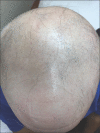Alopecia Areata: Review of Epidemiology, Clinical Features, Pathogenesis, and New Treatment Options
- PMID: 29769777
- PMCID: PMC5939003
- DOI: 10.4103/ijt.ijt_99_17
Alopecia Areata: Review of Epidemiology, Clinical Features, Pathogenesis, and New Treatment Options
Abstract
Alopecia areata (AA) is a complex autoimmune condition that causes nonscarring hair loss. It typically presents with sharply demarcated round patches of hair loss and may present at any age. In this article, we review the epidemiology, clinical features, pathogenesis, and new treatment options of AA, with a focus on the immunologic mechanism underlying the treatment. While traditional treatment options such as corticosteroids are moderately effective, a better understanding of the disease pathogenesis may lead to the development of new treatments that are more directed and effective against AA. Sources were gathered from PubMed, Embase, and the Cochrane database using the keywords: alopecia, alopecia areata, hair loss, trichoscopy, treatments, pathogenesis, and epidemiology.
Keywords: Alopecia; alopecia areata; alopecia totalis; alopecia universalis; hair loss.
Conflict of interest statement
There are no conflicts of interest.
Figures





References
-
- Lundin M, Chawa S, Sachdev A, Bhanusali D, Seiffert-Sinha K, Sinha AA, et al. Gender differences in alopecia areata. J Drugs Dermatol. 2014;13:409–13. - PubMed
-
- Alkhalifah A. Alopecia areata update. Dermatol Clin. 2013;31:93–108. - PubMed
-
- Gandhi V, Baruah MC, Bhattacharaya SN. Nail changes in alopecia areata: Incidence and pattern. Indian J Dermatol Venereol Leprol. 2003;69:114–5. - PubMed
Publication types
LinkOut - more resources
Full Text Sources
Other Literature Sources
Medical

